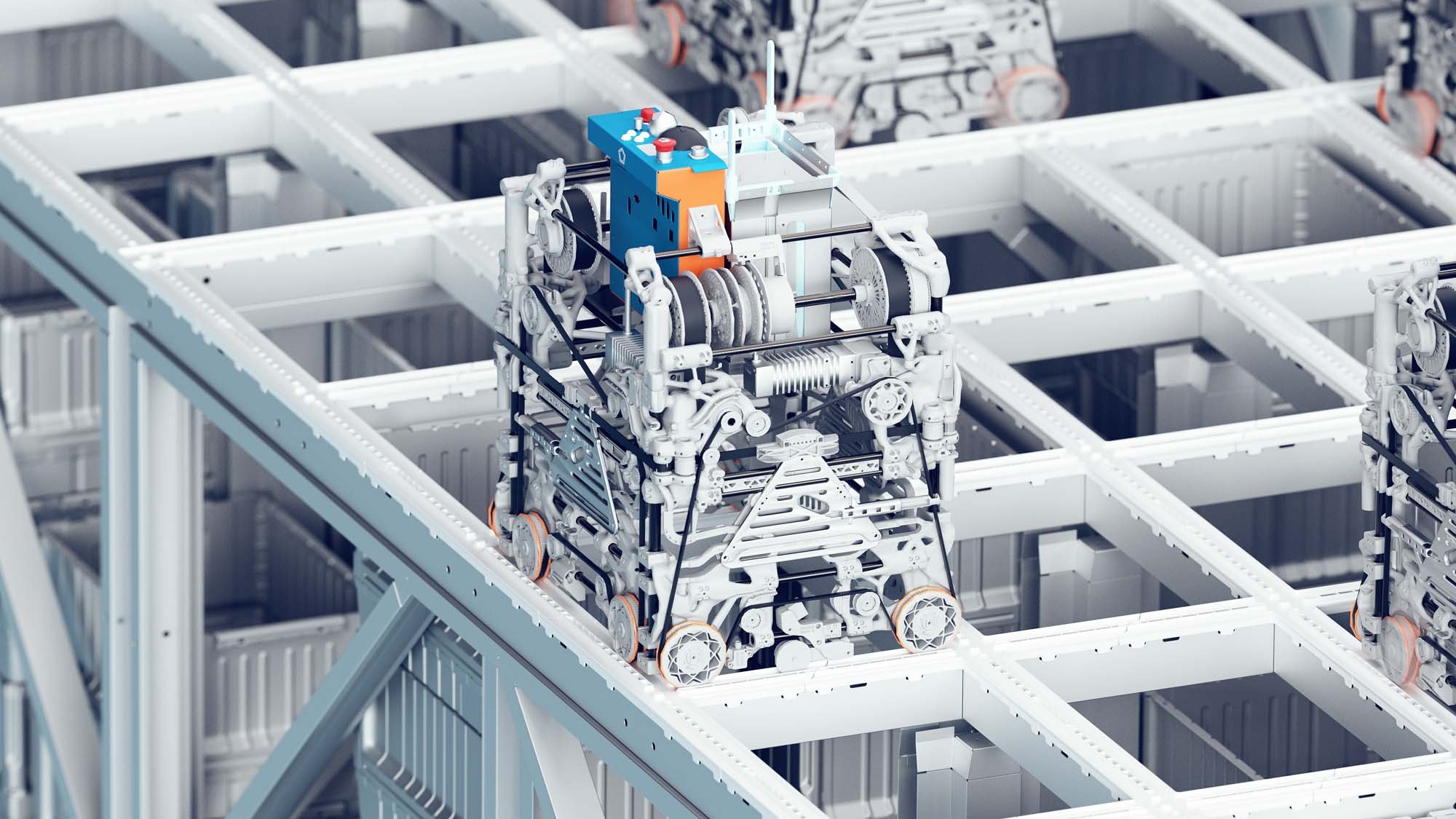Cubic automated storage and retrieval systems (ASRS) store stock in dense, uniform grids, with stock bins stacked on top of one another. The speed at which these bins can be surfaced from within the grid—a process called bin digging—can significantly impact overall warehouse throughput.
The Ocado Storage and Retrieval System (OSRS) is a cutting-edge cubic ASRS system, employing fast, lightweight picking robots constructed from carbon fiber and 3D printed materials.
While our robots offer market-leading speeds and productivity, we believe emphasizing how fast they can dig downward is a bit of a misnomer. See, while robots are digging they can’t be picking—so the overall throughput of the system is naturally reduced.
Instead of focusing on dig speed, we look to minimize it altogether. Using patented software algorithms built into the OSRS warehouse execution system (WES), we constantly optimize warehouse slotting during operational hours. We call this ‘smart putaway’, and it means our robots need to dig as infrequently as possible, reducing the number of robots required, avoiding congestion and achieving greater overall throughput.
In Ocado-operated grocery customer fulfillment centers (CFCs), over 60% of bin retrievals require no digging at all—as they have been carefully placed on the top layer of the grid for rapid access. Smart putaway, also known as ‘directed putaway’, maximizes operational efficiency and warehouse throughput, significantly reducing the time and effort needed to pick, pack and ship items. It contributes to OSRS’ market-leading productivity—typically 3-4 times that of a typical manual warehouse.
What is warehouse slotting?

An illustration of the OSRS grid, showing the effect of smart putaway in optimally locating stock based on future need.
While putaway simply refers to the process of receiving and storing stock within a warehouse, warehouse slotting takes it a step further—using data to optimize placement of stock, thereby minimizing the time and distance required for a human or robot picker to locate and retrieve an SKU. More than just putting stock in the right place, warehouse slotting is a key differentiator in warehouse logistics. Research has shown that 50% of total order picking time is spent traveling in a conventional warehouse—multiply the per-SKU time saved through efficient warehouse slotting and you have a very significant boost in overall throughput.
There are a number of types of warehouse slotting—from fixed slotting (where items are assigned a location and stay there) to zone-based or volume-based slotting, which take into account the type of item (perishables, high value, fast-moving) or its relative size (using smaller shelves for smaller items).
One well-used traditional warehouse slotting approach, ABC slotting, involves positioning the highest-demand SKUs (your ‘A’ movers) near your dispatch areas, reducing the distance and time required for pickers to retrieve items. These methods have benefits in a manual or semi-automated warehouse—your employees, automated guided vehicles (AGVs) or autonomous mobile robots (AMRs) learn where certain SKUs live, don’t have to travel as far, or can be trained or calibrated to handle specific types of items.
Some warehouse management systems (WMS) now offer warehouse optimization strategies, using data to identify better locations for stock based on SKU velocity (a calculation that describes how frequently a SKU is picked from a storage location) and the distance required to pick that item. With this insight, warehouse managers can assess where a particular SKU is stored and move it to a more efficient location within the warehouse.
These strategies vary widely and are highly dependent on the type of automation implemented and how ‘retrofit’ the solution is. In automation that simply augments traditional warehouse racking, warehouse slotting may be affected by a number of logistical factors outside the item’s order frequency, including item size and weight, picker pathways, picking strategy, warehouse layout, item fragility and so on.
How does advanced automation help warehouse slotting?
However, as average inventory sizes have grown to their tens of thousands, the process of warehouse slotting has grown to well beyond human or even semi-automated capabilities. Today’s inventories are also far more fluid, changing in size and contents on a daily—sometimes even hourly—basis, while seasonal demand and social media trends promote ‘D’ movers to ‘A’ movers overnight.
That’s where our unique, patented smart putaway algorithms come in. As a cubic ASRS, OSRS already solves many of the slotting complexities of traditional warehousing—as all items are stored and picked in the same way within the grid, in the same size bins and with the same route in and out. By removing variables such as picker pathways, picking strategy and warehouse layout, cubic ASRS enables us to focus on optimizing the key variables of SKU velocity and stock availability.
Learn more: Why Cubic ASRS Is the Key to Future-Proofing Your Warehouse
Smart putaway calculates the most appropriate place to return a stock bin on-the-fly—which may be an entirely different area of the grid than it was before. It takes into account when the SKU first entered the grid, its current SKU velocity, demand forecasting (including seasonal and market trends), the use-by date or date code of that particular batch and many other unique data points.
“Smart putaway minimizes bin digging, as well as the need for bin preparation. The result is a long term reduction in energy consumption over solutions requiring out-of-hours housekeeping.”
Anne-Marie Neatham, OIA
Does OSRS still need to perform bin digging?
Smart putaway may reduce the need for robots to dig down through a stack of bins, yet it’s still an essential process in any cubic ASRS solution—and naturally becomes more prevalent the higher the grid is stacked. Bin digging ensures that your diverse customer base is able to order those eclectic B, C and D movers located lower in the grid.
To access these items, the WES instructs our robots to join forces in rapidly ‘digging’ by picking up and relocating bins to other cells within the grid until they reach the bin they need. Smart putaway is employed here, too, to ensure bins are moved to the next most suitable location based on their contents.
Does OSRS still need to perform bin preparation?
We’re often asked whether OSRS offers ‘bin preparation’, sometimes called warehouse housekeeping. This is an out-of-hours activity in which robots perform bin digging as maintenance to prepare the grid for the next period of activity. This might mean returning bins containing high-velocity SKUs, buried during the day’s operations, to cells at the top of the grid.
In our existing sites, bin preparation is rendered unnecessary by smart putaway. This means our bots don’t need to be used out of operational hours (and downtime between shifts doesn’t need to be planned in), which would require additional charging and unnecessary run hours on equipment. Removing the need for bin preparation also results in more consistent performance, as the grid does not ‘degrade’ in putaway quality throughout a shift.
However, bin preparation could be an advantage in certain scenarios. We can enable this feature in any use case in which bin digging is more likely, or:
- In use cases with long periods of reduced activity: On quieter days, we can enable bin preparation to maximize your robot fleet.
- For long-lead-time orders: Using bin preparation to organize and prioritize stock ahead of time, we can ensure timely and accurate order fulfillment for orders requiring preparation queues.
- When stock movement patterns are unpredictable: How closely your sales follow a particular Pareto distribution can have a significant effect on throughput and the need to dig bins. In scenarios where demand is unevenly distributed across products, enabling bin preparation allows for more efficient handling of high-demand items, reducing the frequency and impact of bin digging.
During initial conversations with you, we’ll explore the above points in order to understand whether you might benefit from out-of-hours bin preparation.
Want To Learn More?
Our expert team is ready to discuss your unique requirements and provide a customized solution that revolutionizes your fulfillment operations.
@4x.png?width=642&height=166&name=OIA_Logomark_color_(R)@4x.png)





